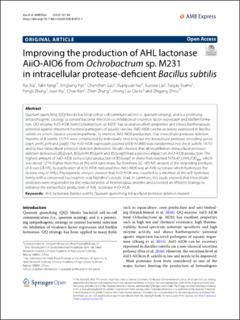| dc.contributor.author | Xia, Rui | |
| dc.contributor.author | Yang, Yalin | |
| dc.contributor.author | Pan, Xingliang | |
| dc.contributor.author | Gao, Chenchen | |
| dc.contributor.author | Yao, Yuanyuan | |
| dc.contributor.author | Liu, Xuewei | |
| dc.contributor.author | Teame, Tsegay | |
| dc.contributor.author | Zhang, Fengli | |
| dc.contributor.author | Hu, Juan | |
| dc.contributor.author | Ran, Chao | |
| dc.contributor.author | Zhang, Zhen | |
| dc.contributor.author | Clarke, Jihong Liu | |
| dc.contributor.author | Zhou, Zhigang | |
| dc.date.accessioned | 2021-01-26T15:11:37Z | |
| dc.date.available | 2021-01-26T15:11:37Z | |
| dc.date.created | 2021-01-04T17:28:12Z | |
| dc.date.issued | 2020-08-05 | |
| dc.identifier.citation | Intensive Care Medicine. 2020, 10 . | en_US |
| dc.identifier.issn | 0342-4642 | |
| dc.identifier.uri | https://hdl.handle.net/11250/2724834 | |
| dc.description.abstract | Quorum quenching (QQ) blocks bacterial cell-to-cell communication (i.e., quorum sensing), and is a promising antipathogenic strategy to control bacterial infection via inhibition of virulence factor expression and biofilm formation. QQ enzyme AiiO-AIO6 from Ochrobactrum sp. M231 has several excellent properties and shows biotherapeutic potential against important bacterial pathogens of aquatic species. AiiO-AIO6 can be secretory expressed in Bacillus subtilis via a non-classical secretion pathway. To improve AiiO-AIO6 production, four intracellular protease-deletion mutants of B. subtilis 1A751 were constructed by individually knocking out the intracellular protease-encoding genes (tepA, ymfH, yrrN and ywpE). The AiiO-AIO6 expression plasmid pWB-AIO6BS was transformed into the B. subtilis 1A751 and its four intracellular protease-deletion derivatives. Results showed that all recombinant intracellular protease-deletion derivatives (BSΔtepA, BSΔymfH, BSΔyrrN and BSΔywpE) had a positive impact on AiiO-AIO6 production. The highest amount of AiiO-AIO6 extracellular production of BSΔywpE in shake flask reached 1416.47 U/mL/OD600, which was about 121% higher than that of the wild-type strain. Furthermore, LC–MS/MS analysis of the degrading products of 3-oxo-C8-HSL by purification of AiiO-AIO6 indicated that AiiO-AIO6 was an AHL-lactonase which hydrolyzes the lactone ring of AHLs. Phylogenetic analysis showed that AiiO-AIO6 was classified as a member of the α/β hydrolase family with a conserved “nucleophile-acid-histidine” catalytic triad. In summary, this study showed that intracellular proteases were responsible for the reduced yields of heterologous proteins and provided an efficient strategy to enhance the extracellular production of AHL lactonase AiiO-AIO6. | en_US |
| dc.language.iso | eng | en_US |
| dc.publisher | Springer Nature | en_US |
| dc.rights | Navngivelse 4.0 Internasjonal | * |
| dc.rights.uri | http://creativecommons.org/licenses/by/4.0/deed.no | * |
| dc.title | Improving the production of AHL lactonase AiiO-AIO6 from Ochrobactrum sp. M231 in intracellular protease-deficient Bacillus subtilis | en_US |
| dc.type | Peer reviewed | en_US |
| dc.type | Journal article | en_US |
| dc.description.version | publishedVersion | en_US |
| dc.rights.holder | © The Author(s) 2020 | en_US |
| dc.source.pagenumber | 9 | en_US |
| dc.source.volume | 10 | en_US |
| dc.source.journal | Intensive Care Medicine | en_US |
| dc.identifier.doi | 10.1186/s13568-020-01075-7 | |
| dc.identifier.cristin | 1865156 | |
| dc.source.articlenumber | 138 | en_US |
| cristin.ispublished | true | |
| cristin.fulltext | original | |
| cristin.qualitycode | 1 | |

